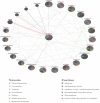The function annotations of ST3GAL4 in human LAMP1 and Lassa virus GP-C interaction from the perspective of systems virology
- PMID: 32974605
- PMCID: PMC7497829
- DOI: 10.1099/acmi.0.000146
The function annotations of ST3GAL4 in human LAMP1 and Lassa virus GP-C interaction from the perspective of systems virology
Abstract
Lassa virus (LASV) is a single-stranded RNA virus that has plagued the Sub-Saharan part of Africa, precisely Nigeria where various pathogenic strains with varied genomic isoforms have been identified. The human lysosomal-associated membrane protein 1 (LAMP1) is alternately required for the micropinocytosis of LASV. Therefore, it is of interest to understand the mechanism of action of the host LAMP1 with LASV protein during infection. The role of ST3 beta-galactoside alpha-2, 3-sialyltransferase 4 (ST3GAL4) in the interaction between LASV (glycoprotein) GP-C and the human LAMP1 is relevant in this context. Deposited curated protein sequences of both LAMP1 and LASV GP-C were retrieved for the study. The ST3GAL4 associated data was constructed and analysed from weighted network analysis to infer the function annotations and molecular mediators that characterize the LASV infection. The gene network shows that glycoprotein sialylation, sialyltransferase enzymatic activities and glycosphingolipid biosynthesis are linked with the ST3GAL4 function. However, the physical interaction of FAM 213A, CD8B molecule and proprotein convertase subtilisin/kexin type 1 inhibitor (PCSK1N) with ST3GAL4 is intriguing in this perspective. There are 11 glycosylated asparagine sequons of the human LAMP1 but only nine were assigned a sialylated glycan cap to mediate the LASV GP-C and LAMP1 interaction having exceeded a recommended glycosylation threshold of 0.5. Therefore, the sialylated glycans of the human LAMP1 are a total of nine and these sialylated glycans mediate the molecular recognition between LASV and LAMP1. This study therefore, predicts that there is a cellular interchange between N-linked glycosylation properties of the human LAMP1 and LASV glycoprotein, and sialylation functions of ST3GAL4 in LASV infectivity. Further studies and the clinical trial of this predictive model on the sialylated glycans of LAMP1 will facilitate the understanding of the LASV micropinocytosis process in host cells.
Keywords: Glycosylation; LAMP1; Lassa virus; Neural network; ST3GAL4; Sialylation.
© 2020 The Authors.
Conflict of interest statement
The authors declare that there are no conflicts of interest.
Figures







References
-
- Buchmeier MJ, De la Torre JC, Peters CJ. Arenaviridae: The Viruses and Their Replication. Philadelphia, PA, USA: Wolters Kluwer Health/Lippincott Williams & Wilkins; 2007.
-
- Ogbu O, Ajuluchukwu E, Uneke CJ. Lassa fever in West African sub-region: an overview. J Vector Borne Dis. 2007;44:1–11. - PubMed
LinkOut - more resources
Full Text Sources
Research Materials
Miscellaneous
